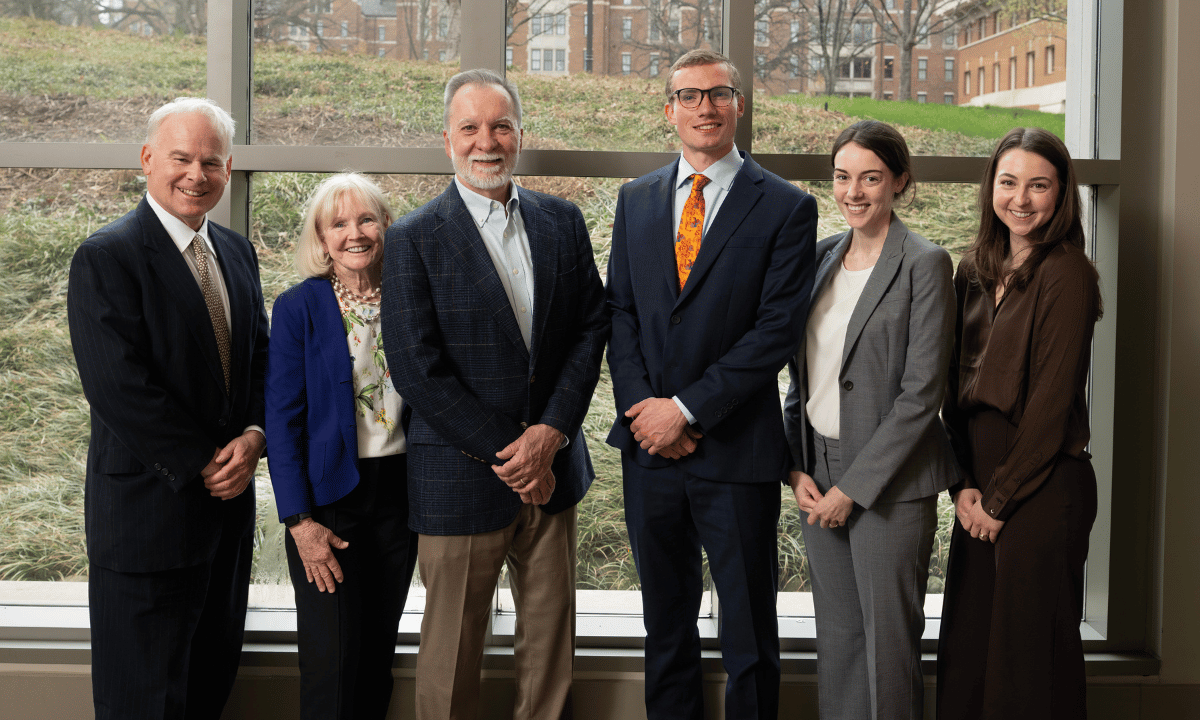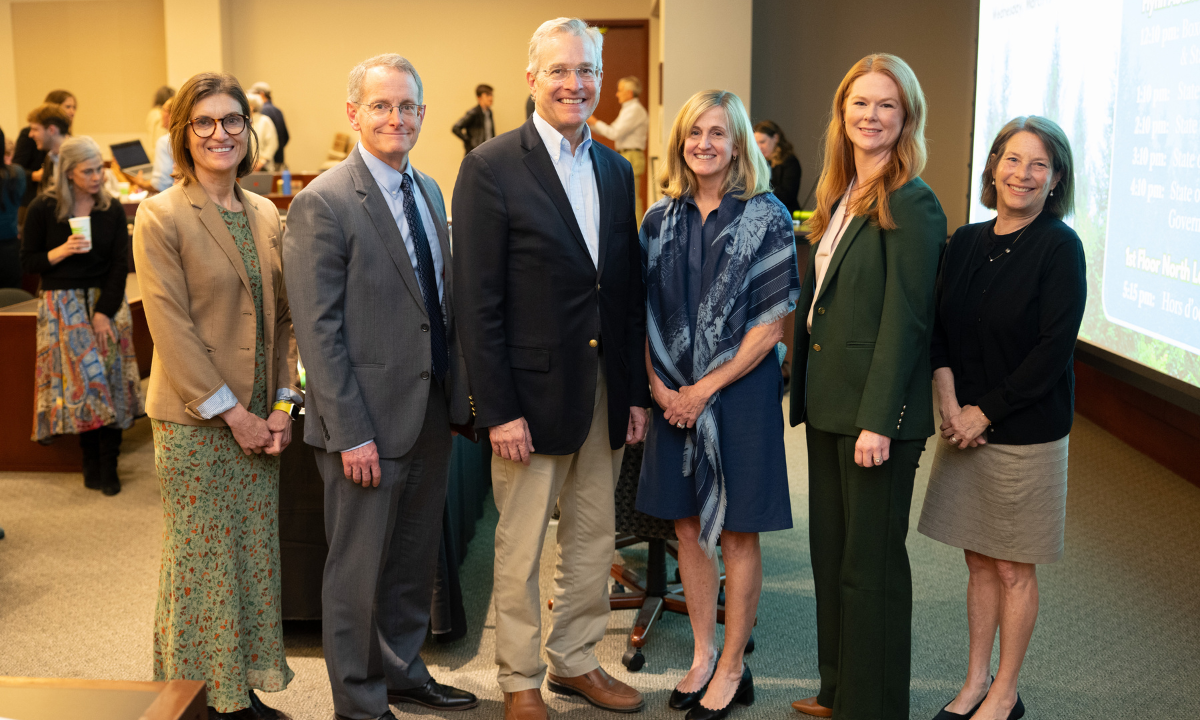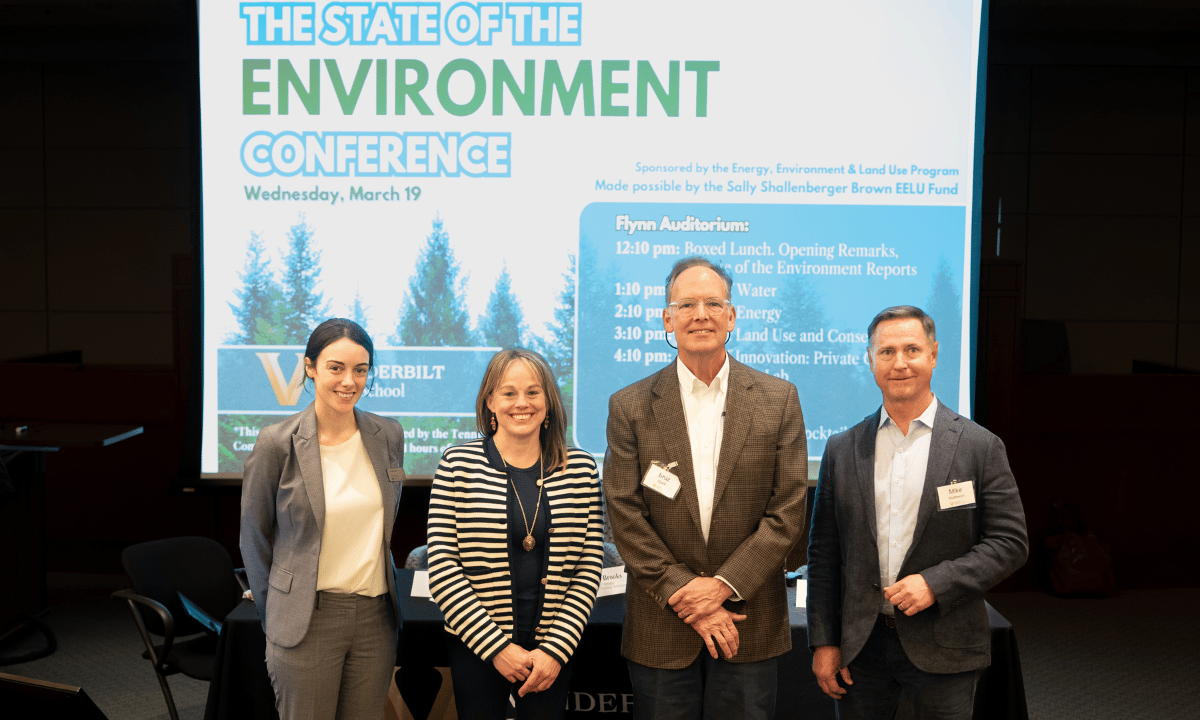by Ethan Thorpe, Giorgio Chioin LLM’25, and Rena Childers JD’26
The Third-Annual State of the Environment Conference, held by the Vanderbilt Law School’s Energy, Environment, and Land Use (EELU) Program, took place on March 19 at Vanderbilt Law School. Faculty, policymakers, and experts discussed a wide range of issues affecting Nashville and the Southeast, as well as potential solutions. The conference was supported by the Sally Shallenberger Brown Program Fund.
State of the Environment Report Presentation
 The State of Environment panel detailed key environmental indicators at the local, state, regional, and national level. In addition to highlighting important trends, the panel focused on present issues such as climate resiliency, artificial intelligence, and energy burden. Moderated by EELU Co-Director Michael Vandenbergh, the panel featured Dr. Mariah Caballero, doctoral student in Vanderbilt’s Community Research and Action Program; Ethan Thorpe, Climate Governance Fellow at the Vanderbilt Private Climate Governance Lab; and Erin Hafkenschiel, President of ThinkTennessee.
The State of Environment panel detailed key environmental indicators at the local, state, regional, and national level. In addition to highlighting important trends, the panel focused on present issues such as climate resiliency, artificial intelligence, and energy burden. Moderated by EELU Co-Director Michael Vandenbergh, the panel featured Dr. Mariah Caballero, doctoral student in Vanderbilt’s Community Research and Action Program; Ethan Thorpe, Climate Governance Fellow at the Vanderbilt Private Climate Governance Lab; and Erin Hafkenschiel, President of ThinkTennessee.
Ethan Thorpe opened the panel with a brief introduction to this year’s Special Issues on the removal of public climate information, the energy demand of artificial intelligence, and building climate resilience in the Southeast, which are available at the end of this year’s State of the Environment Report. He went on to detail key findings on conservation, climate, and energy. Key points included the precarious position of Tennessee’s highly biodiverse freshwater species, the growing threat of climate hazards in the state, and rapid progress towards low carbon energy sources.
Mariah Caballero followed with the report’s sections on air, water, and waste. She pointed to several promising trends while noting that there is still important work to be done in these areas. For instance, decommissioning and adding scrubbers to coal-fired power plants has drastically improved Tennessee’s air quality, but significant room for improvement remains due to high transportation emissions and relatively slow EV uptake. Meanwhile, though Tennessee generally has cleaner drinking water than the rest of the Southeast and nation, water quality in lakes and rivers has deteriorated over the past two years. Finally, she pointed to Nashville’s challenges in meeting its 2025 solid waste targets.
Erin Hafkenschiel presented ThinkTennessee’s vastly expanded State of the State dashboard. She focused on Tennessee’s energy, with particular focus on resident needs. She emphasized the high energy burden many Tennesseans face – not due to high energy rates (which tended to be below average relative to the U.S.) – but due to high consumption. She drew attention to the need for greater investments in household efficiency to help under resourced communities save money on their energy bills. Her presentation built on findings about Tennessee’s clean energy transition, but also underscored the improvement needed in terms of grid reliability in a state with among the highest rates of blackouts.
State of Energy
 The State of Energy panel provided a comprehensive discussion on the evolving energy landscape, touching on renewable energy expansion, demand response strategies, and the increasing challenges posed by rising energy consumption. Moderated by Anne Davis from Vanderbilt Law School, the panel featured Ernie Peterson, Regional Director of Customer Relations at Tennessee Valley Authority (TVA), Brent Baker, VP & Chief Customer and Innovation Officer at Nashville Electric Service (NES), and Brian Blackmon, Senior Account Manager at Milepost Consulting and former Director of the City of Knoxville’s Office of Sustainability.
The State of Energy panel provided a comprehensive discussion on the evolving energy landscape, touching on renewable energy expansion, demand response strategies, and the increasing challenges posed by rising energy consumption. Moderated by Anne Davis from Vanderbilt Law School, the panel featured Ernie Peterson, Regional Director of Customer Relations at Tennessee Valley Authority (TVA), Brent Baker, VP & Chief Customer and Innovation Officer at Nashville Electric Service (NES), and Brian Blackmon, Senior Account Manager at Milepost Consulting and former Director of the City of Knoxville’s Office of Sustainability.
Ernie Peterson opened the discussion by outlining TVA’s unique role as a federally owned but self-funded utility. He emphasized TVA’s commitment to balancing energy generation, economic development, and environmental stewardship, highlighting that 60 percent of its total generation comes from non-emitting sources such as nuclear, hydro, and solar power. As part of its ongoing renewable energy efforts, TVA has set an ambitious goal of achieving 10,000 megawatts of solar power by 2035, with 1,400 megawatts already operational and an additional 2,800 megawatts under contract. Peterson underscored the importance of energy efficiency, stressing that the most cost-effective and cleanest energy is the energy that does not need to be produced. He detailed TVA’s efforts in energy efficiency and demand response programs, which help customers reduce consumption at peak times and adopt more efficient technologies.
Brent Baker followed with a discussion of NES’ initiatives, which are focused on making energy efficiency more accessible to customers. He highlighted programs that offer home energy audits, rebate opportunities for energy-efficient upgrades, and targeted projects aimed at low-income elderly residents to help reduce energy burdens. He also spoke about NES’ approach to demand response, which includes dynamic voltage reduction and time-of-use pricing strategies to shift electricity consumption away from peak demand periods. In addition, Baker noted that NES is working on electric vehicle managed charging initiatives to optimize grid capacity and ensure that EV adoption does not strain the system. He expressed enthusiasm about ongoing collaborations with TVA to develop distributed solar energy solutions, acknowledging that while NES currently operates under a five percent cap on solar generation, discussions are underway to explore opportunities for expanding this limit.
Brian Blackmon provided a broader perspective on the future challenges facing the energy sector, particularly the dramatic increase in electricity demand driven by AI data centers. He warned that AI and cloud computing are fundamentally changing the way utilities plan for future energy needs. While data centers currently account for only a small fraction of total electricity demand, projections indicate that this figure could rise to more than 20 percent by 2030. This rapid growth is forcing utilities to reconsider their infrastructure planning, potentially delaying the retirement of fossil fuel plants to meet short-term capacity requirements. Blackmon stressed that grid modernization, microgrids, and expanded demand response programs will be essential tools in addressing these challenges.
State of Innovation
The State of Innovation panel highlighted the growing role private organizations can play amid governmental rollbacks of climate and environmental regulations. Panelists discussed the current private climate governance landscape, opportunities to accelerate adoption, and potential hurdles to decarbonization. Moderated by EELU Co-Director and David Daniels Allen Distinguished Chair in Law J.B. Ruhl, the panelists included Michael Vandenbergh, David Daniels Allen Distinguished Chair in Law and EELU Co-Director; Jeff Gowdy, Senior Director at Sustainserv; and Ethan Thorpe, Climate Governance Fellow at Vanderbilt’s Private Climate Governance Lab.
Michael Vandenbergh opened with a general discussion of the concept of private environmental governance. Private environmental governance occurs when private organizations perform environmental functions traditionally associated with governments such as informational disclosures, standard setting and enforcement, and compliance investigations. He pointed to the important gaps that private organizations can fill to buy society time as climate action suffers from severe polarization. He identified several incentives that may motivate persistent private action, even as governments pull back from climate and environmental governance.
Jeff Gowdy followed with his perception as a veteran in private practice in the sustainability space. He described his experience as a sustainability consultant for major firms, explaining how companies perform private climate governance, some tools they use, and the opportunities it may present. He noted that attention is sometimes not evenly distributed across different functions – namely reporting, planning, and implementation – with a need for greater focus on implementation. He also highlighted the role that supply chains and supply chain management can play in achieving climate goals.
Ethan Thorpe concluded by describing the Private Climate Governance Lab’s ongoing projects, pointing to the interdisciplinary nature of private climate governance. He explained how the opportunities and threats to private organizations make climate action an “everything problem,” meaning actors at every level and in every space have reasons to prioritize their environmental initiatives. He went on to clarify how this vision of climate action as a wide-ranging issue that can unify different stakeholders informs the Lab’s work, namely how it pushes the Lab to integrate diverse stakeholders in their projects and goals.
State of Land Use
The Land Use panel, moderated by EELU Program Director Caroline Cox, featured Harriet Brooks, Planning Manager, Metro Nashville Planning Department; Bruz Clark, President and Treasurer, Lyndhurst Foundation; and Mike Matteson, Community Development Director, Williamson County. 
Planning Growth in Nashville
Brooks describes Nashville as being in its “adolescent phase,” because it is experiencing rapid growth in many ways, and because this growth has yet to be constrained, it comes with growing pains. There are three major growing pains–three key issues in tension with each other that the Metro Nashville Planning Department must grapple with when making decisions for the city.
Demand for more housing vs. infrastructure and zoning capacity limits
Brooks described the Nashville Next plan put forth in 2015 and how the growth predictions compare to the actual numbers today. The number of jobs increased more than projected, which is positive, and the population increased a little more than projected. One negative gap in these predictions is we need many more housing units than we are currently producing. In trying to produce more housing, the city must balance zoning considerations and preservation of both natural spaces and culturally significant built spaces, such as historic East Nashville neighborhoods that don’t have the capacity for more housing units.
Development and urbanization vs. conservation of environment and character
According to Brooks, many Nashvillians feel that the city is growing too fast, specifically feeling like we are “losing our sense of place identity.” She acknowledged there have been failures to properly plan to balance sprawling urbanization and conserving environment and character, and the Department is embarking on a conservation ecology strategy for planning this year. It is engaging in negotiations with an environmental engineering and design firm that would help the Department understand relevant ecological conditions, set conservation priorities, and making recommendations for planning based on these things.
Tourism economy vs. resident quality of life
The third growing pain involves balancing the tourism industry in Nashville (which makes up a significant portion of both the Nashville and Tennessee economy) with the quality of life of residents. Brooks noted many residents feel as if the city is growing for tourists, not residents. An example of this tension is demonstrated in the Belle Meade neighborhood where Cheekwood is located. There is only one road in and out of this popular attraction, so this results in a significant number of cars on that road every day, far exceeding the recommended level of traffic/noise for a residential neighborhood.
Preserving Rural Character in Williamson County
Matteson spoke on the current conversation surrounding growth in neighboring Williamson County. The needs of Williamson County differ from Nashville because instead of urban, its character is a mix of suburban and rural, and that rural landscape and small town feel is key to its sense of identity.
A comprehensive land use plan put forth in 2007 reflected desires to preserve the rural landscapes, but it did not call for changes in established rural densities. This led to a “leapfrogging” effect, where urban growth expanded over its desired boundaries into rural areas. Matteson described the conversations around the 2020 plan update as a “policy fork in the road”: the County could either try to focus growth strategically and preserve its rural character (“Town and Country”) or focus growth strategically and concede to the urban sprawling pattern that has continued (“Business As Usual”).
The three criteria for evaluating the two plans were community character, traffic and road improvement, and overall fiscal impacts. Notably, the cumulative cost of growth for Business as Usual would be $5 billion and only $1.5 billion for Town and Country. There was overwhelming support by the public, the advisory committee, and the County Planning Commission to pursue the Town and Country Plan. As a result, Williamson County successfully changed its zoning guidelines in rural areas to try to maintain its signature small town charm and rural character.
Conservation in Chattanooga
Clark concluded the panel with a description of the mission and achievements of the Lyndhurst Foundation in Chattanooga, which utilizes “a place-based approach to land use and conservation.” This approach emphasizes the intersection between the economic and cultural values in an urban environment as well as access to nature. Clark displayed images of downtown Chattanooga in the 1980s and today, and the difference is astounding. Before, the urban environment was a dreary concrete jungle that lacked any feeling or character. That area has been revitalized to incorporate the natural environment into the urban, creating a space that invites the community to utilize and enjoy the space rather than just pass through.
Another project that reflects this place-based approach to land use and conservation is the Cumberland State Scenic Trail, and it incorporates all “six Cs” that the Lyndhurst Foundation uses when evaluating conservation projects: conservation, connectivity, community, creative placemaking, cardiovascular (health), and cash (economy). Clark’s ultimate goal is to complete the Cradle of Southern Appalachia Initiative, which aims to protect 1 million acres of Appalachian woodlands. He concluded with some words to live by: “build a better environment, better than the one we inherited.”